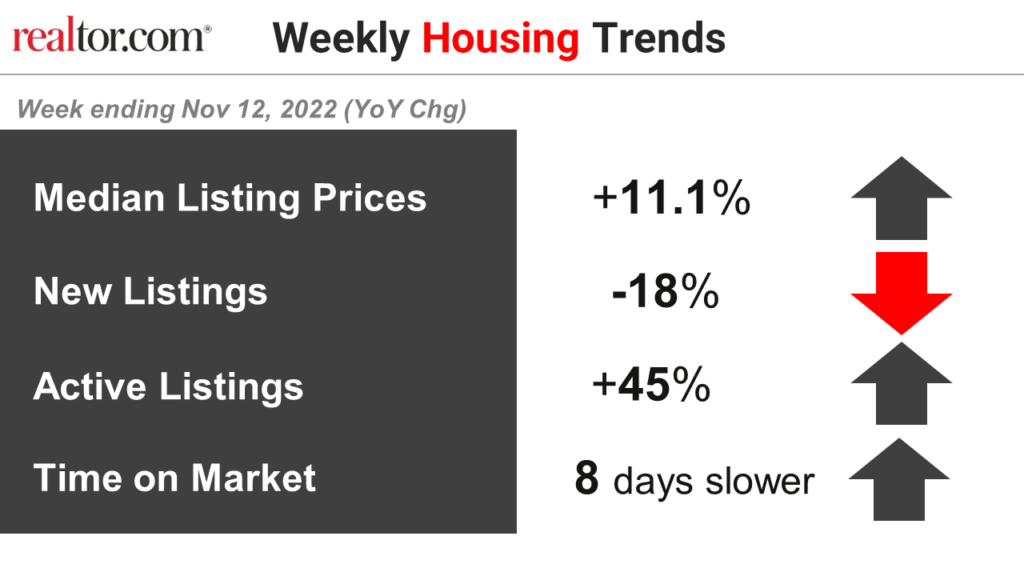Our research team releases regular monthly housing trends reports. These reports break down inventory metrics like the number of active listings and the pace of the market. In addition, we continue to give readers more timely weekly updates, an effort that began in response to the rapid changes in the economy and housing as a result of the COVID-19 pandemic. Generally, you can look forward to a Weekly Housing Trends View and the latest weekly housing data on Thursdays with a weekly video update from our economists on Fridays. Here’s what the housing market looked like over the last week.
What this Week’s Data Means:
Today’s homebuyers and sellers are dealing not just with higher housing costs, but more uncertainty as a result of fluctuating mortgage rates. In 2022, absolute week to week changes in mortgage rates have averaged 16 basis points, more than three times the 5 basis point average from 2009 to 2021. And this week’s data due out later today is likely to continue this trend, with a sizable drop that could be nearly 50 basis points below last week’s mortgage rates. A dip of this magnitude would mean roughly $100 less in monthly mortgage costs for buyers financing 90% of a $425,000 home, the median listing price in October. Expanded purchasing power is undoubtedly a good thing for today’s shoppers, but fluctuations make it difficult to budget and plan for buyers and sellers alike.
The uncertainty is leading to hesitation. As both buyers and sellers pull back, median listing prices are slowing and new listings are down even though longer time on market is driving the number of homes actively for sale on any given day higher.
One of the major drivers of mortgage rate volatility is the outlook for inflation and what it means for short- and long-term interest rates and economic prospects. At the Fed’s November meeting, Chair Powell pointed to the need for ongoing rate hikes to tame inflation. Just 8 days later October inflation data surprised to the downside, resetting market expectations for what’s ahead and raising the possibility of more volatility down the road.
Key Findings:
- The median listing price grew by 11.1% over last year. The typical asking price of for-sale homes continues to exceed last year’s level by double-digits, hitting a 46th week at double-digit pace. However, the pace of growth retreated again, continuing the more sizable deceleration that began the last week of October. In last week’s data, we noted that the pace of median listing price growth could move back into single digit territory just before the end of the year and with this week’s step-down, that possibility is still very much on the table. This means the typical asking price will near, but not likely slip below $400,000 again this year. The Realtor.com October Housing Trends Report showed that the typical price of a home for sale on Realtor.com was $425,000, down from summer’s peak of $450,000.
- New listings–a measure of sellers putting homes up for sale–were again down, dropping 18% from one year ago. This marks the nineteenth week of year over year declines in homeowners listing their home for sale, a tangible reflection of the ongoing decline in seller confidence. Because potential sellers have pulled back so significantly, prices are decelerating in a more modest fashion than might otherwise be the case.
- Active inventory continued to grow, increasing 45% above one year ago. Inventory accelerated again, notching a fifth straight week of gains roughly at or above 2% after a fair amount of stability between July and September. Fewer newly listed homes would normally cause a decline in inventory, but buyers have retreated from the housing market as higher and more uncertain costs make it difficult to ascertain purchasing power and set a budget. In particular, the variability of mortgage rates in 2022 is likely a major source of frustration for home shoppers. For example, last week, mortgage rates were above 7% for the second time in 3 weeks according to data from Freddie Mac. However, data out later today is widely expected to show that mortgage rates dropped well below 7%. This dip, which will likely exceed 25 basis points, could mean roughly $100 less in monthly mortgage costs for buyers financing 90% of a $425,000 home, the median listing price in October. Expanded purchasing power is undoubtedly a good thing for today’s shoppers who have navigated an average week to week swing of 16 basis points in mortgage rates so far year-to-date, the biggest swings since 2008 and more than three times the average 5 basis point swing seen in 2009 to 2021.
- Homes spent eight extra days on the market compared to this time last year. This is the sixteenth week in a row that homes spent more time on market compared to last year. Earlier in the year, inventory gains were driven by increasing numbers of new sellers seeking to capitalize on high home prices and a sellers’ market. Now, inventory gains are a reflection of the fact that homes take longer to sell, which gives buyers more options to choose from on any given day. Still, well priced homes may sell quickly, and days on market remain below what was common before the pandemic.
Data Summary:
| All Changes year-over-year | Year-to-Date 2022 | Week ending Oct 29, 2022 | Week ending Nov 5, 2022 | Week ending Nov 12, 2022 |
| Median Listing Prices | +13.9% | +12.0% | +11.7% | +11.1% |
| New Listings | -6% | -13% | -20% | -18% |
| Active Listings | +8% | +40% | +42% | +45% |
| Time on Market | 4 days faster | 6 days slower | 7 days slower | 8 days slower |
Note: With the release of its September 2022 Housing Trends Report, Realtor.com® incorporated a new and improved methodology for capturing and reporting housing inventory trends and metrics. The new methodology updates and improves the calculation of time on market and improves handling of duplicate listings. Most areas across the country will see minor changes with a smaller handful of areas seeing larger updates. As a result of these changes, the data released since September 29, 2022 will not be directly comparable with previous data releases (files downloaded before September 29, 2022) and Realtor.com® economics blog posts. However, future data releases, including historical data, will consistently apply the new methodology.
Subscribe to our mailing list to receive updates and notifications on the latest data and research.

